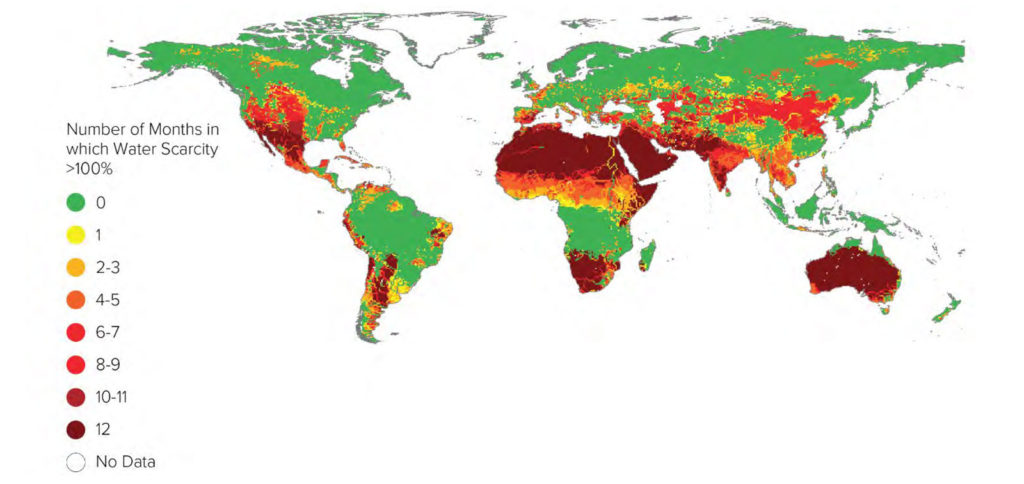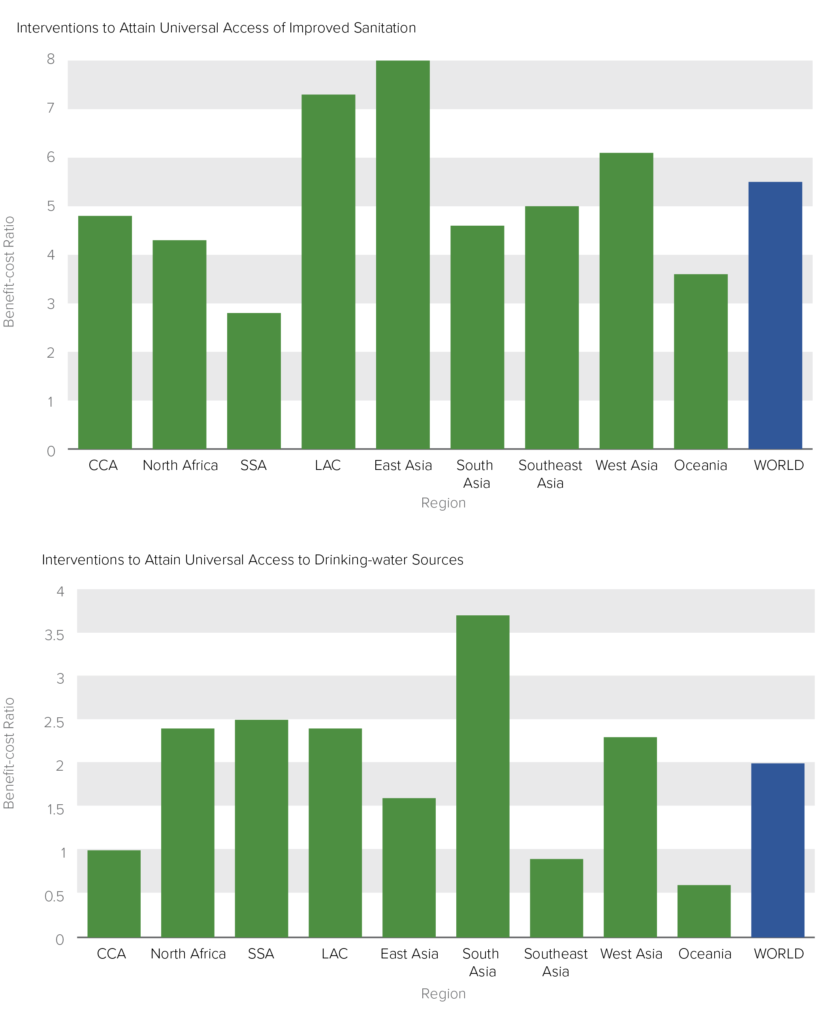The world will need to invest around US$90 trillion by 2030 to close the global infrastructure gap.89 Around 20% of this is the infrastructure needed for water resources management and water and sanitation services, for which investment needs by 2030 are estimated at US$0.9–1.5 trillion per year.90 While infrastructure renovation and upgrade are needed in developed countries, roughly two-thirds of the global infrastructure investment that is required will be in the global South.91 Here, especially,investments can help to bridge the adaptation gap and reduce poverty.92 For example, a small share of total global water infrastructure spending – an estimated US$0.1 trillion per year, mainly in developing and emerging economies – could secure access to safely managed drinking water and sanitation for all (SDG targets 6.1 and 6.2). These volumes of finance, while relatively modest, are still more than three times historic investment trends.93Currently, billions lack these essential services, exposing them to diseases like diarrhoea (still a leading cause of death globally);94 imposing huge burdens on well-being, dignity, and productivity; and undermining their ability to cope with climate change. Similar deficits are found in infrastructure for water storage, irrigation, and flood defence, which are needed to manage rainfall variability and climate extremes.95
Infrastructure in other sectors also needs to contribute to water security and withstand water-related climate risks such as floods, droughts, and rainfall variability.96 Not only are 40% of India’s power plants located in highly water-stressed areas, but the country’s largest power utilities lost more than US$1.4 billion in potential revenue due to water shortage-related disruptions between 2013 and 2016.97 The transition to a low-carbon economy is not immune to water risk. Hydropower dams being built on Africa’s Zambezi and Nile rivers, for example, are clustered in areas with high rainfall variability, increasing the risk of a single dry period interrupting electricity generation and critical energy services.98 Under one clean energy scenario, water withdrawals could be reduced by 12% by 2040, but in other scenarios with more biofuels, concentrating solar, carbon capture and storage, and nuclear in the mix, the amount consumed (not available to other users downstream) could still increase by 2%. Impacts are dependent on the exact mix of technologies and how they are distributed in relation to available water.99
Excitingly, innovations are opening up new possibilities for water system design and management, for example, in ICT, circular economy approaches, and nature-based solutions. China’s Spong City project, for example, aims for 70% of rainwater to be absorbed and reused across 80% of its urban areas by 2030, through a mix of green and grey infrastructure.100 Initial results include reduced urban waterlogging and improvement of water-related ecosystems, as well as improved public satisfaction.101 While interest rates may be low, financing challenges must also be overcome, not only to find the money but to make spending more climate-smart.102 That means embedding climate resilience as well as mitigation into infrastructure investments. This can be done by ensuring that international grant finance goes towards increasing access to basic infrastructure, including drinking water and sanitation services in the poorest countries, and incentivising resilience and reduced emissions. In emerging and developed economies, domestic and concessional international finance, including through MDBs, can crowd in private investment in infrastructure. Much more can be done to direct this private investment to infrastructure that offers resilience as well as mitigation co-benefits. And private finance can also incentivise improved and mainstreamed assessment, disclosure, and action on water-related and other climate risks across infrastructure projects and portfolios.
Evidence of the Benefits
The return on investment from conventional water and sanitation infrastructure and services is high. At the global level, every dollar invested in sanitation returns on average US$5.5 in benefits, and every dollar invested in drinking water supply returns US$2 (Figure 28).103 Adequate water supply, sanitation, and hygiene for all could avert the deaths of 361,000 children under the age of five every year.104 In urban slums particularly, closely packed living conditions, inadequate infrastructure, and poverty combine to increase disease risk.105 Investments in water storage and conveyance infrastructure also carry significant benefits. In 2010, securing water for existing irrigators could have generated global welfare gains of US$94 billion.106
Well-constructed and managed water supply networks, sanitation systems, storage, flood defences, and early warning systems are also a foundation of resilience to climate change and water-related extremes. Nonetheless, water and sanitation infrastructure, and indeed all infrastructure, needs to be made more resilient through better choice of technology, siting, and, above all, improved policies, governance, and management. There will be costs to this. Adaptation costs for water supply and riverine flood protection, for instance, have been estimated at US$27–34 billion per year from 2010 to 2050.107 A related challenge is that it is not always easy to quantify the benefits especially if they accrue over time.
There are clear advantages to acting now. First, including a more comprehensive assessment of risk and design in adaptability from the outset may not be more expensive than conventional approaches and could even be cheaper. Here, there is an increasingly recognised role for nature-based solutions to help build resilience to climate change and disasters, as an alternative to fixed concrete infrastructure. Nature-based solutions are frequently emphasised in National Adaptation Programmes of Action,108 and there are many opportunities to use them in water management. In the United States, the DC Water utility has, for example, invested in natural or green infrastructure to manage stormwater and prevent pollution of rivers, allowing it to adaptively increase capacity in ways that large concrete infrastructure often prohibits, as well as spread costs more smoothly for its ratepayers over time. The utility also raised US$350 million in 2014 for its wider Clean Rivers project through a municipal century bond with a 100-year tenure – the first of its kind in the United States. Attracting over US$1 billion in market interest, there are signs that smart investors are increasingly looking for this kind of long-term, green opportunity.109 DC Water has issued a further US$200 million in green bonds110 and in 2016 pioneered an innovative US$25 million environmental impact bond, again the first of its kind in the United States (see Box 45).111
 The 2018 Report of the Global Commission on the Economy and Climate
The 2018 Report of the Global Commission on the Economy and Climate

